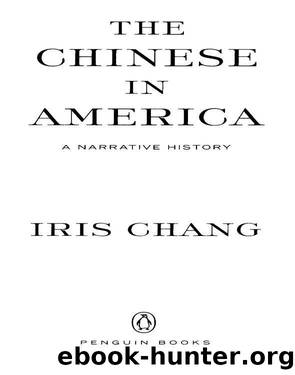The Chinese in America: A Narrative History by Iris Chang

Author:Iris Chang [Chang, Iris]
Language: eng
Format: epub
Tags: HBC, History
ISBN: 9781101126875
Google: 1a7gXiXnKF0C
Barnesnoble:
Goodreads: 10318461
Publisher: Penguin
Published: 2003-01-02T00:00:00+00:00
CHAPTER FIFTEEN
New Arrivals, New Lives: The Chaotic 196Os
In the 1960s, the Chinese in America may have looked to outsiders like one people with a shared culture, shared traditions, and a shared immigration experience. But this was not the case, nor was it for most other immigrant groups. As discrimination against each immigrant group abates over generations, and the enticement of assimilation increases, ethnic ties are rarely strong enough to bind people of different aspirations and talents to a monolithic group identity. This is especially true when immigration is a continuing process, and later arrivals tend to push earlier arrivals out of the ghettos.
In the 1960s, anti-Chinese discrimination remained strong, but the ethnic Chinese were also no longer bottled up in Chinatowns, as they once were, dependent upon community organizations to protect their rights, their livelihood, and at times their lives. Indeed, some newer arrivals—the intellectuals and those members of the educational and social elite of China who had managed to find their way, however circuitously, to the United States—had not even passed through America’s Chinatowns. They had moved directly into university towns and cities, aided by their English-language skills. They also benefited from the fact that America, whose Declaration of Independence held as self-evident that “all men are created equal,” was about to confront the fearful reality of its own racism.
Of this group of Chinese in America, the intellectuals, mostly graduate students stranded in the United States by the 1949 revolution in China, were likely to socialize and associate with other intellectuals of Chinese descent. But intellectual communities were already becoming the first outposts of multiculturalism, and Chinese scholars were able to participate in university town life without being self-conscious about their non-Caucasian appearance and speech patterns. As I look back on my own youth as the daughter of two academics, growing up in the community organized around the University of Illinois at Urbana-Champaign, I remember driving to Chicago Chinatown with my family, but only for the same reason Americans of other ethnicities went there—for a particularly good Chinese meal, not to strengthen any connection to my roots.
In addition, as previously noted, by the 1960s quite a few Chinese Americans had been born in the United States. If others saw them as Chinese, not American, that was their problem. Many of these Chinese Americans saw themselves first as Americans, albeit of Chinese descent, and their only real knowledge of the “old country” came through stories they heard from their parents and grandparents. This lack of personal connection was particularly true of the children of the earliest immigrant waves, especially those I refer to as the “long dispersed” immigrants, whose ancestors had left the American Chinatowns long ago. Many now lived and worked in suburban areas throughout the country, and their children had relatively few contacts with other people of their own race. The children’s lives were in many ways indistinguishable from those of the children of other immigrant groups.
But for Chinese who did not feel secure enough to move out
Download
This site does not store any files on its server. We only index and link to content provided by other sites. Please contact the content providers to delete copyright contents if any and email us, we'll remove relevant links or contents immediately.
| African-American Studies | Asian American Studies |
| Disabled | Ethnic Studies |
| Hispanic American Studies | LGBT |
| Minority Studies | Native American Studies |
Cecilia; Or, Memoirs of an Heiress — Volume 1 by Fanny Burney(31332)
Cecilia; Or, Memoirs of an Heiress — Volume 3 by Fanny Burney(30934)
Cecilia; Or, Memoirs of an Heiress — Volume 2 by Fanny Burney(30889)
The Great Music City by Andrea Baker(21313)
We're Going to Need More Wine by Gabrielle Union(18072)
Bombshells: Glamour Girls of a Lifetime by Sullivan Steve(13108)
Pimp by Iceberg Slim(12931)
All the Missing Girls by Megan Miranda(12747)
Fifty Shades Freed by E L James(12451)
Norse Mythology by Gaiman Neil(11883)
Talking to Strangers by Malcolm Gladwell(11876)
Crazy Rich Asians by Kevin Kwan(8349)
Mindhunter: Inside the FBI's Elite Serial Crime Unit by John E. Douglas & Mark Olshaker(7834)
The Lost Art of Listening by Michael P. Nichols(6473)
Enlightenment Now: The Case for Reason, Science, Humanism, and Progress by Steven Pinker(6405)
Bad Blood by John Carreyrou(5769)
The Four Agreements by Don Miguel Ruiz(5511)
Weapons of Math Destruction by Cathy O'Neil(5036)
We Need to Talk by Celeste Headlee(4868)
